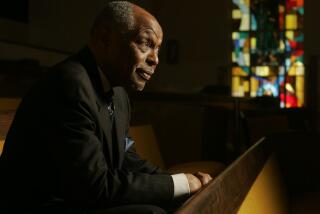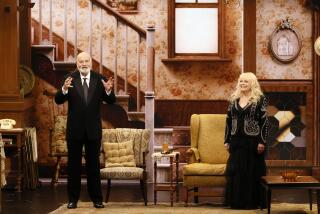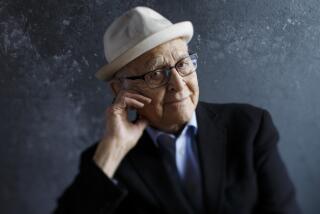Leary’s Style Imbues His Memorial Service
- Share via
Timothy Leary would have loved it.
They streamed into the battered airport hangar by the hundreds Sunday to pay tribute to him, the fun-loving symbol of the psychedelic ‘60s who died May 31 after a long bout with cancer.
This was the public memorial, held next to the runway of the Santa Monica Airport, where planes took off and landed throughout a two-hour service that featured incense and the warmest of words for the man whose name became synonymous with psychedelic drugs, in particular LSD.
Two hours of elegies ebbed and flowed through the airplane din and the hot, cavernous hangar acoustics, but there was a noticeable decibel decline from the crowd when actress Winona Ryder, Leary’s goddaughter, took the stage. Her message was simple: Leary’s impact on her growing up had been profound.
“He was the first person who made me believe I could do anything,” she said. “What I learned from him wasn’t about drugs, it was about getting by.”
Those who came both to speak and to listen were from all walks--and flights--of life. Some looked as though their roads had been tough ones, while others wore the jewelry and well-tailored suits of the wealthy. Some wore tie-dyed pants and shirts, while another arrived on roller-blades.
And they came in all ages, from the elderly who were the contemporaries of the 75-year-old Leary to the young devotees with whom he surrounded himself in the last years of his life.
The mix of people was not lost on David Reisner, a consultant to entertainment and investment executives, who was standing off to the side of the crowd. He said he had known Leary about five years.
“He had a constant stream of people through his house, especially on the weekends,” Reisner said. “He was very alive and active and interested in a very broad range of things. His home was a good place for fostering creativity and interacting.”
There were eight speakers in all, ranging from an old friend from Leary’s Harvard days to his granddaughter.
Each, in his or her own way, made the point that Leary may forever be linked with drugs and the ‘60s in the public’s mind, but that he was much more than that. To them, he possessed one of the brightest, most able minds that they had ever come across; he was not, as Richard Nixon once described him, “the most dangerous man in America.”
His friend of 35 years, psychologist Ram Dass, formerly Harvard colleague Richard Alpert, said Leary had awakened a new person in him when they met, pulling him out of what he described as “middle-class playwalking.”
“He taught me to play with life rather than be played with by life,” Dass said.
Author Robert Anton Wilson talked of Leary’s years in prison and said he believed the psychologist had been unjustly punished for drug-related offenses that should not have been a crime.
“The only crime he committed was speaking the truth as he understood it,” he said.
As more speakers took to the podium, those in the audience came and went, looking for a cool drink and a place to grab a smoke. A bearded man with long blond hair made his way up and down the aisles, spreading the smoke of the incense with a feather.
Others lay on the cool concrete floor, staring up at the rafters of the cavernous building. Still more gathered in clumps at the back of the room, talking among themselves because of the difficulty of understanding the speakers, who were burdened with terrible acoustics.
At last, the lights went down for a film collage of Leary and his life. Set to Beatles music, it traced Leary’s life--as a young man, through the flower child decade and, finally, to his deathbed.
And when the lights came back up, Ryder, her eyes moist, walked out the huge hangar doors.
More to Read
Sign up for Essential California
The most important California stories and recommendations in your inbox every morning.
You may occasionally receive promotional content from the Los Angeles Times.









